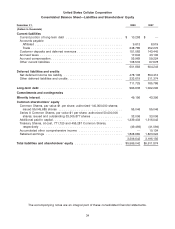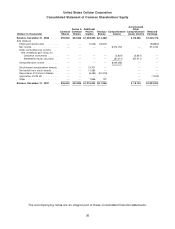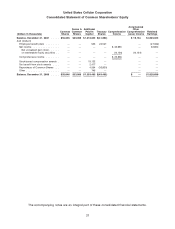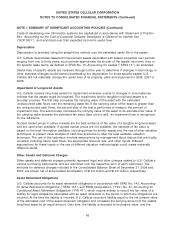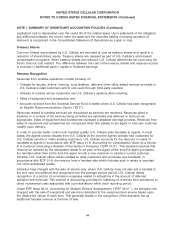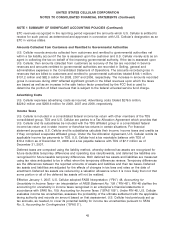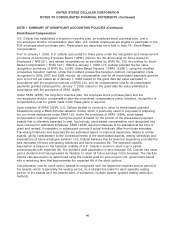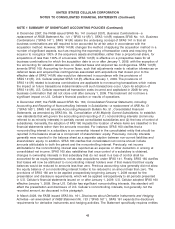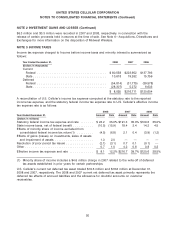US Cellular 2008 Annual Report Download - page 163
Download and view the complete annual report
Please find page 163 of the 2008 US Cellular annual report below. You can navigate through the pages in the report by either clicking on the pages listed below, or by using the keyword search tool below to find specific information within the annual report.UNITED STATES CELLULAR CORPORATION
NOTES TO CONSOLIDATED FINANCIAL STATEMENTS (Continued)
NOTE 1 SUMMARY OF SIGNIFICANT ACCOUNTING POLICIES (Continued)
with FCC rules and policies. U.S. Cellular believes that it could demonstrate its entitlement to a
renewal expectancy in any of its markets in the unlikely event that any of its license renewal
applications were challenged and, therefore, believes that it is probable that its future license renewal
applications will be granted.
Goodwill
U.S. Cellular has goodwill as a result of its acquisitions of wireless markets. Such goodwill represents the
excess of the total purchase price of acquisitions over the fair values of acquired assets, including
licenses and other identifiable intangible assets, and liabilities assumed.
Impairment of Intangible Assets
Licenses and goodwill must be reviewed for impairment annually or more frequently if events or changes
in circumstances indicate that any of such assets might be impaired. U.S. Cellular performs the required
annual impairment review on its licenses and goodwill during the second quarter of its fiscal year. U.S.
Cellular also performed an impairment test on its licenses and goodwill in the fourth quarter of 2008 as a
result of the further deterioration in the credit and financial markets and the accelerated decline in the
overall economy.
The intangible asset impairment test consists of comparing the fair value of the intangible asset to its
carrying amount. If the carrying amount exceeds the fair value, an impairment loss is recognized for the
difference. The goodwill impairment test is a two-step process. The first step compares the fair value of
the reporting unit to its carrying value. If the carrying amount exceeds the fair value, the second step of
the test is performed to measure the amount of impairment loss, if any. The second step compares the
implied fair value of reporting unit goodwill with the carrying amount of that goodwill. To calculate the
implied fair value of goodwill in this second step, an enterprise allocates the fair value of the reporting
unit to all of the assets and liabilities of that reporting unit (including any unrecognized intangible assets)
as if the reporting unit had been acquired in a business combination and the fair value was the price
paid to acquire the reporting unit. The excess of the fair value of the reporting unit over the amount
assigned to the assets and liabilities of the reporting unit is the implied fair value of goodwill. If the
carrying amount of goodwill exceeds the implied fair value of goodwill, an impairment loss is recognized
for that difference.
Quoted market prices in active markets are the best evidence of fair value of an intangible asset or
reporting unit and are used when available. If quoted market prices are not available, the estimate of fair
value is based on the best information available, including prices for similar assets and the use of other
valuation techniques. Other valuation techniques include present value analysis, multiples of earnings or
revenues, or similar performance measures. The use of these techniques involve assumptions by
management about factors that are highly uncertain including future cash flows, the appropriate discount
rate, and other inputs. Different assumptions for these inputs or different valuation methodologies could
create materially different results.
U.S. Cellular tests goodwill for impairment at the level of reporting referred to as a reporting unit. For
purposes of impairment testing of goodwill in 2008, U.S. Cellular identified five reporting units pursuant
to paragraph 30 of SFAS 142. The five reporting units represent five geographic groupings of FCC
licenses, representing five geographic service areas. U.S. Cellular tests licenses for impairment of the
level of reporting referred to as a unit of accounting. For purposes of its annual impairment testing of
licenses in the second quarter of 2008, U.S. Cellular combined its FCC licenses into nineteen units of
accounting pursuant to FASB Emerging Issues Task Force (‘‘EITF’’) Issue 02-7, Units of Accounting for
Testing Impairment of Indefinite-Lived Intangible Assets (‘‘EITF 02-7’’) and SFAS 142. Of these, fourteen of
such nineteen units of accounting represented geographic groupings of licenses which, because they
41





